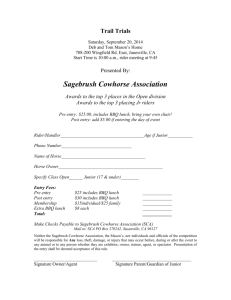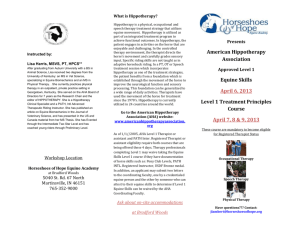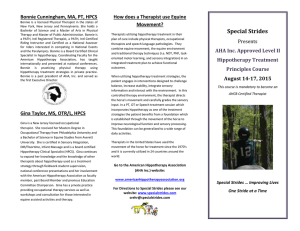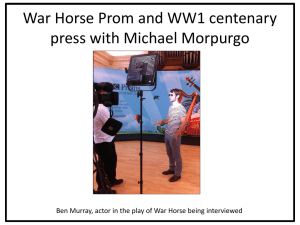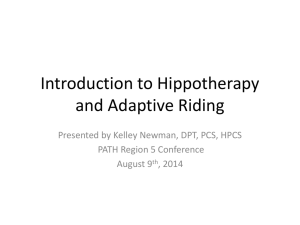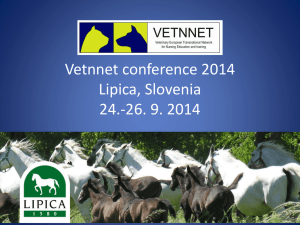to view the presentation.
advertisement
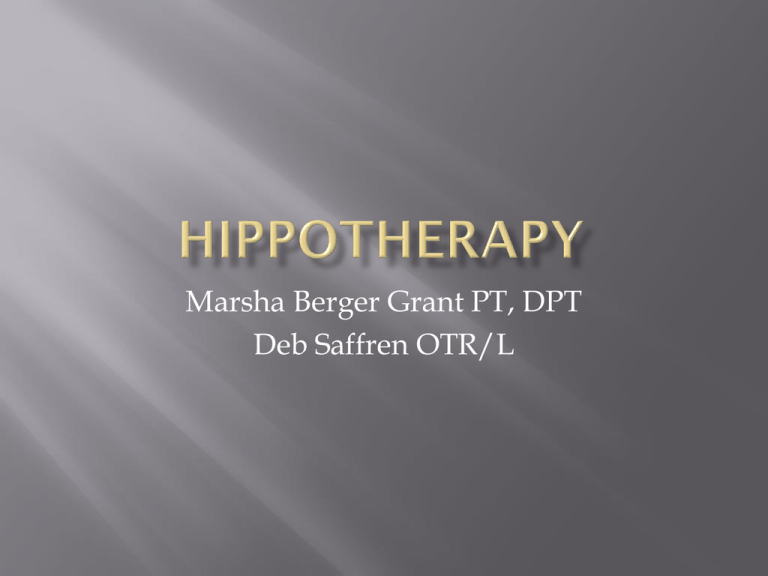
Marsha Berger Grant PT, DPT Deb Saffren OTR/L Hippotherapy is a physical, occupational or speech-language therapy treatment strategy that utilizes equine movement as part of an integrated intervention program to achieve functional outcomes. The horses movements provide carefully graded motor and sensory input. It has been practiced in North America since the 1970s and is practiced in many countries throughout the world. Misnomer Any PT, OT or SLP who uses a horse as a modality can do hippotherapy, but there are no hippotherapists. Special Equestrian's Mission To improve the physical, mental, and emotional well being of individuals with disabilities through the equine experience. 32 years of nonprofit service to the community 249 riders in 2013 60 different diagnoses 3,900 lessons in 2013 100+ volunteers per week (+ corporate groups) 14 therapy horses 3 full-time, 14 part-time staff, 2 vocational workers Participants in research in the field Fees charged to all riders only 50% of cost to SE 30% of riders receive additional tuition assistance Three dimensional movement of the horse This 3 D movement leads to an adaptive response in the rider’s pelvis which is similar to the movement patterns of human walking which in turn affects core control and posture. It is the only therapeutic treatment strategy in which we can provide patients with sustained 3 dimensional movement. Changing the gait allows for degree of input Looking at the whole experience of the rider to make it a safe, fun and successful interaction with the horse and environment to promote increased self esteem and self efficacy. PTs- promote functional outcomes in skill areas related to gross motor ability such as sitting, standing, and walking. OTs -fine motor control, sensory integration, feeding skills, attentional skills, visual perception and functional daily living skills in a progressively challenging manner. SLP - generate effective remediation of communication disorders and promote functional communication outcomes. Overlap of all three disciplines in each lesson. Ages 2+ Weight restrictions Autism Cerebral Palsy Developmental Delay Arthritis Adults with gait dysfunction = MS, PD TBI CVA Chromosomal Disorders Sensory Processing Disorders In dwelling catheter Scoliosis greater than 30 degrees Poor Unsupported Sitting Posture Uncontrolled Grand Mal seizure Combative behavior Unstable hip SIDE WALKERS HORSE LEADERS • • • • • • • For the horse Therapy saddle Rainbow reins Ladder reins Black Handle Reins Devonshire stirrups Wedges Boppy pillow For the rider Safety belt Sensory balls Flash cards • • • • • • • • • • • Improve posture Increase balance/core control Increase ROM Increase attention span Decrease anxiety Improve behavior Increase safety awareness Normalize tone Improve speech Increase attention, sensory processing Improve functional grasp, crossing midline Parental response Changes in Posture Coordination Behavior Communication skills Fine and gross motor abilities To be promoted to therapeutic riding which allows for a lifelong program to maintain gains and to offer a recreational activity for lifelong enjoyment. Noodle Toss Carwash S: rider’s parent reports rider was sick this week O: 30 minute hippotherapy session on Bear. Required mod assist of 2 to mount at ramp. Worked on balance with quick stops and starts, reaching across midline with noodle toss and grasping activities with ball drop. A: Weakness noted with increased assistance to mount and postural assist needed at trunk rather than hips. As expected due to illness. P: Continue w/ same horse/tack. Attempt mount with less assist as able Does horseback riding therapy or therapistdirected hippotherapy rehabilitate children with cerebral palsy? Dev Med Child Neurol. 2007 Jan;49(1):68-73 Reviewed 11 quantitative studies – 6 for recreational horseback riding therapy and 5 for hippotherapy Methodological quality was moderate to good for all studies Hippotherapy improved gross motor function in all studies Video: Ride On St Louis Participates in Hippotherapy & Cerebral Palsy Study at Washington University Tim Shurtleff OTR/L Measured stability in head and trunk via computer assisted analysis Riders on mechanical horse, then lessons, then retest Positive improvements immediately and 6 months post. SE- The happiest Place on Earth “There is something about the outside of a horse that is good for the inside of a man.” Winston Churchill

